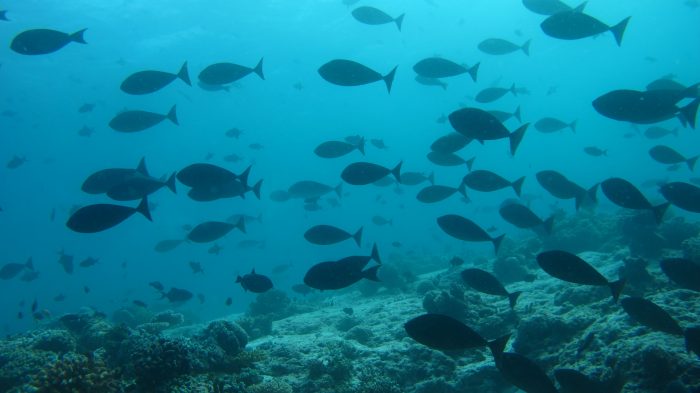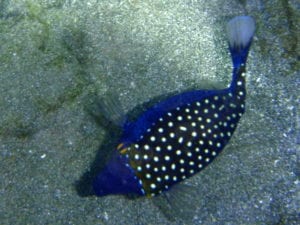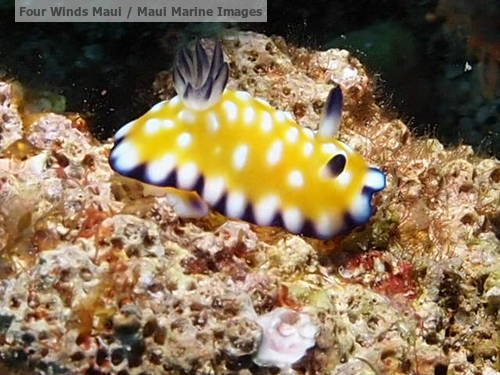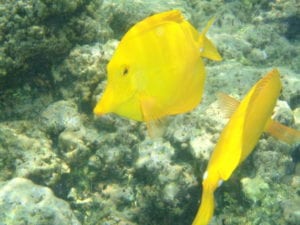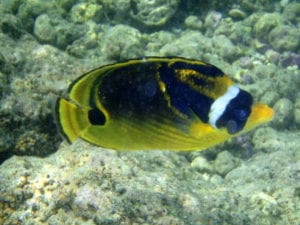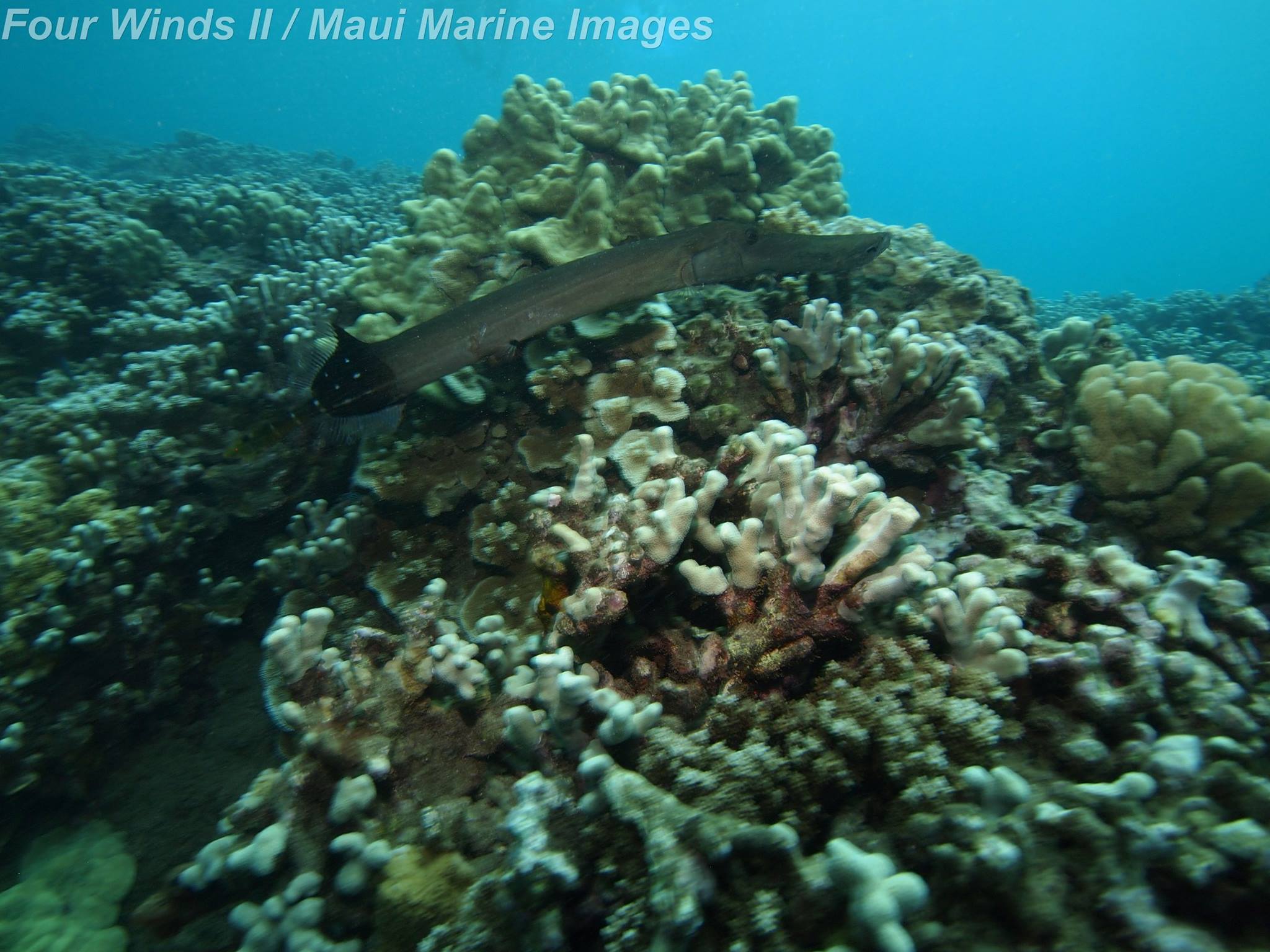What Fish Will I See While Snorkeling in Maui?
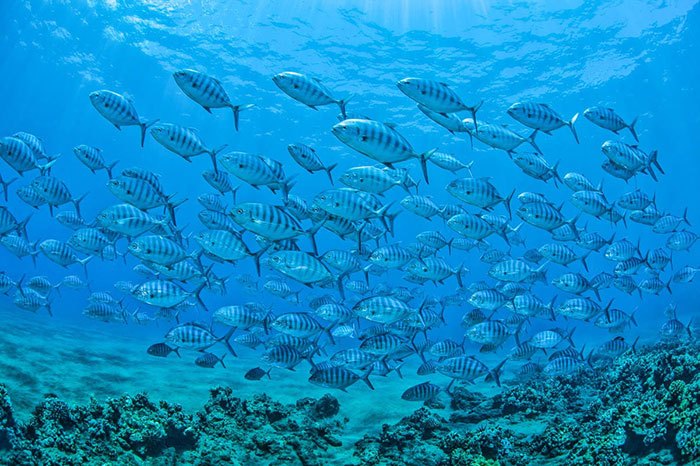
Maui is one of the best destinations for snorkeling. The island of Maui has one of three volcanic caldera craters in the world, Molokini Crater. Molokini is home to thousands of tropical fish, coral species, algae, and multiple types of marine life. Coral Gardens is another top snorkel site, which is also located on Maui. Both of these destinations provide snorkelers a chance to see the beautiful underwater aquarium that Maui naturally provides.
We have put together a list of 10 Hawaiian fish (with pictures and videos) that you can most likely see while snorkeling. Most of these fish are found on the shallow reef and rocks. This list is a great way to start and lets you know some of the fish you want to look out for while snorkeling Maui.
The Four Winds II has two daily snorkel tours; the morning tour goes to Molokini Crater and the afternoon tour typically goes to Coral Gardens (all weather permitting). Both tours offer a fantastic snorkeling experience that you will surely remember.
1. Parrotfish Uhu
Parrotfish are the largest and most colorful of the reef fish in Hawaii. Sizes range from 10-40 inches. Adult fish have fused front teeth, that almost resemble a parrot like beak, hence where they get their name. Similar to wrasses, the female parrotfish can change her sex and become a male. Most parrotfishes are omnivores and feed on algae.
2. Black Durgeon Triggerfish humuhumu ‘ele’ele
One of the most common species of fish you will spot during your snorkeling adventure at Molokini is the black durgeon triggerfish. The average size ranges from 10 – 12 inches long. Triggerfish mainly feed on zooplankton and algae. The black durgeon is most commonly found in the water column. Triggerfish are quite territorial and aggressive towards other reef fish.
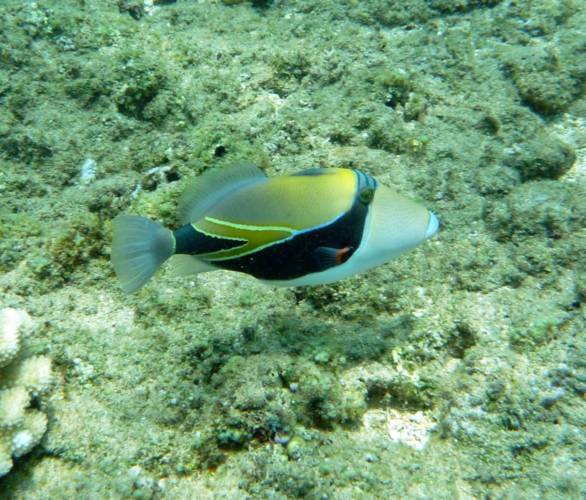 3. Lagoon Triggerfish Humuhumunukunukuapua`a
3. Lagoon Triggerfish Humuhumunukunukuapua`a
One of the most popular reef fish, the humuhumunukunukuapua`a, is also the Hawaii state fish. The Hawaiian name literally translates to “triggerfish with a snout like a pig”. Typically, the humuhumu are about 6-7 inches and eat algae, small shrimp and crabs. The humu are usually spotted 0-15 feet below the surface and like shallow protected bays. Just like the black durgeon, humu’s are territorial, especially when there are eggs that they are protecting.
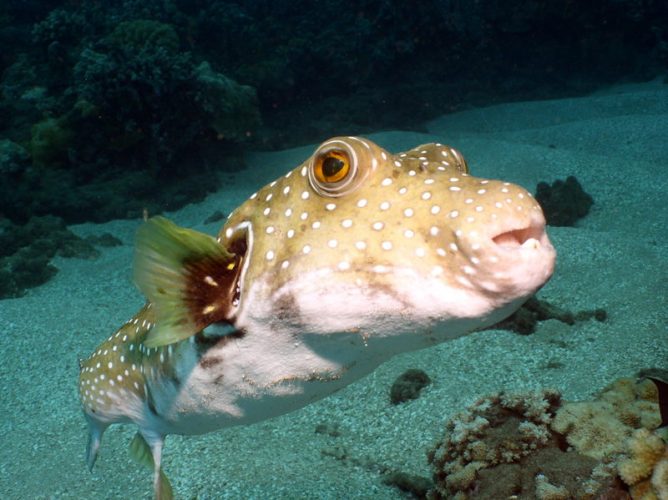 4. Stripebelly Pufferfish O’opu hue
4. Stripebelly Pufferfish O’opu hue
The stripebelly is a medium sized puffer, ranging from 14-18 inches long. These puffers are usually found in shallow lagoons and in sandy and rocky areas, so that it can feed on invertebrates. Puffers will usually allow you to approach them within a few feet and then will quickly flee away until it feels safe. Puffers are known for the way inflating their bodies with water (to appear larger) to stop predators from eating them. Another interesting fact about pufferfish is that they can also inflate themselves in a hole so that it becomes impossible for a predator to pull them out. Puffers can be extremely toxic to eat unless you know how to properly prepare them; even then, it can still be very dangerous to consume.
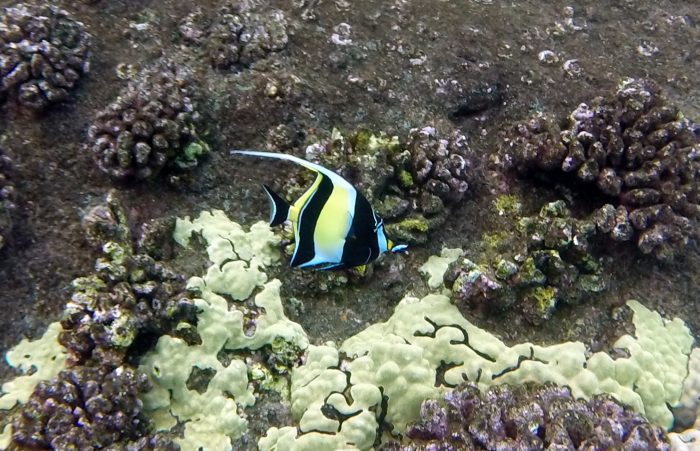 5. Moorish Idol kihikihi
5. Moorish Idol kihikihi
The Moorish idol shares many similar characteristics with the Surgeonfish, but it is the only species in its family. Moorish idols have long and thin snouts, so that they can reach in between crevices while feeding. The average size of a Moorish idol is between 7-9 inches. Moorish idols are one of the most commonly spotted species while snorkeling in Maui. This particular fish mainly feeds on sponges, plant life, and invertebrates.
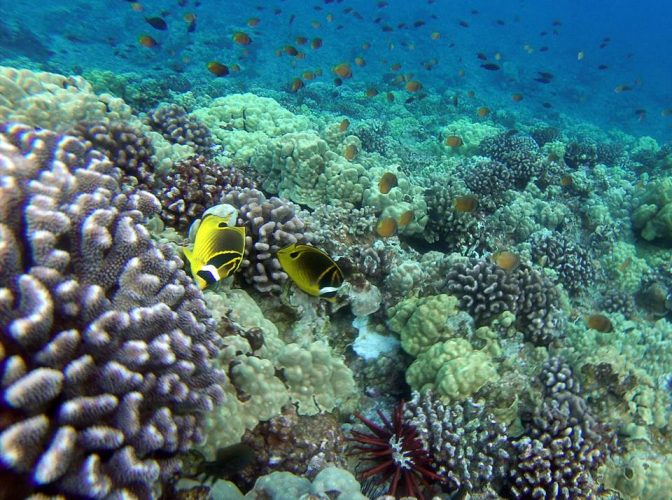 6. Raccoon Butterflyfish Kikakapu
6. Raccoon Butterflyfish Kikakapu
Butterflyfish are some of the most beautiful and colorful fish you can spot while snorkeling Molokini. You can spot them in shallow bays and near the shoreline. Three species of butterflyfish are endemic to Hawaii (found only in Hawaii).
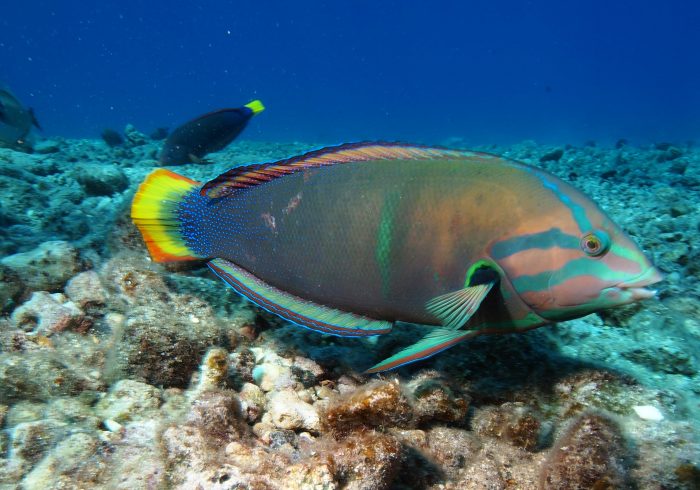 7. Yellowtail Coris Wrasse Hinalea ‘Aki-Lolo
7. Yellowtail Coris Wrasse Hinalea ‘Aki-Lolo
The Wrasse family is one of the most beautiful and diverse categories of fish. Snorkeling in Maui provides such an amazing opportunity to get the chance to see unique and complex marine life. Hawaiian wrasses vary in size, from 2 – 15 inches and are typically carnivorous, feeding mainly on smaller fish and invertebrates. Many wrasses have teeth that they use for eating invertebrates. The wrasse tends to forge for food during the day and sleep under the sand at night.
One of the most interesting facts about the wrasse family is that the female has the ability to change sex. Depending on the females environment, she will sometimes change her sex to become a male to replace one that has passed away. This stops other males from trying to take control of the harem.
8. Yellow Tang Surgeonfish Lau’i-pala
The Yellow Tang is one of the most common fish spotted while snorkeling the Hawaiian reef. Due to the vibrant yellow coloring of this particular tang, it is often the first fish that beginning divers and snorkelers recognize. Tangs graze and eat algae during the day and hide at night. Yellow tangs are usually found in shallow reefs . Male tangs tend to be larger than females. At night, the bright yellow coloring fades and they regain color during day time. Normally, yellow tangs are found alone or in small schools.
9. Spotted Trunkfish (Boxfish) Moa
The trunkfish (also known as a boxfish) is a very unique looking fish. Typically, boxfish move slowly and get the name “boxfish” from there hard outer covering (shell). The trunkfish is a subspecies of those found throughout the Indo Pacific. Trunkfish feed mainly on mollusks, sponges, and algae and are typically 2-4 inches in size. This particular fish is fairly common in Hawaii, and usually seen in small crevices. The male trunkfish has a bright blue color on their sides, while the females are are brown with white spots. Spotted trunkfish are naturally territorial.
10. Trumpetfish Nunu
The trumpetfish is a commonly spotted fish in Hawaii. Trumpetfish have the ability to change color and are able to bend with their surroundings; they often hide amongst sea urchins, finger coral, and natural objects. The average size of a trumpetfish is about 20-25 inches. Nunu feed on smaller fish and crustaceans. The trumpetfish will often hide behind use schools of surgeonfish when hunting for their prey.
Mahaney, Casey. Hawaiian Reef Fish The Identification Book. Lovelock, Nevada. Blue Kirio Publishing, 1993.
Fish At Molokini Crater
The Unicorn, Blue-Lined Snapper & Box Fish
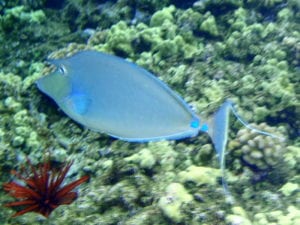 The unicorn fish is in surgeonfin family. They are named after the spike that protrudes from its forehead; however some species have more of a protrusion rather than an actual spike, and some lack a spike altogether. Unicorn fishes usually have a pair of spines on each side of the tail shaft, which they use as a defense mechanism. They are mainly active in daytime and roam in groups feeding on algae. They can grow to around 20-24 inches and have a lifespan of around 15 years. The horn-like appendage between their eyes begins growing when a young fish reaches about 5 inches in length, and tends to be a little bigger on males. They are generally not aggressive to each other, but when they do fight they use sharp scalpels by their tails as weapons, not their horns. Their skin is smooth and less susceptible to skin diseases than that of other fish in their family.
The unicorn fish is in surgeonfin family. They are named after the spike that protrudes from its forehead; however some species have more of a protrusion rather than an actual spike, and some lack a spike altogether. Unicorn fishes usually have a pair of spines on each side of the tail shaft, which they use as a defense mechanism. They are mainly active in daytime and roam in groups feeding on algae. They can grow to around 20-24 inches and have a lifespan of around 15 years. The horn-like appendage between their eyes begins growing when a young fish reaches about 5 inches in length, and tends to be a little bigger on males. They are generally not aggressive to each other, but when they do fight they use sharp scalpels by their tails as weapons, not their horns. Their skin is smooth and less susceptible to skin diseases than that of other fish in their family.
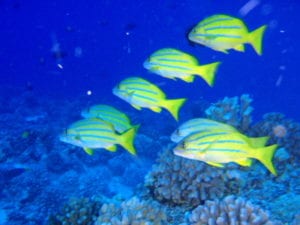 You know you’ve spotted this fish by the lengthwise, light blue lines across it’s bright yellow body. This fish can reach an average length of about 12 inches and generally lives in the deeper waters of the reef in large schools. The Blue-Lined Snapper, also know as Blue-Striped Snapper, orTaape is a Carnivore and will eat crustaceans like crabs and shrimp, along with other smaller marine fishes. Like most Carnivores, if it is something they can get their mouth around they will try and eat it.
You know you’ve spotted this fish by the lengthwise, light blue lines across it’s bright yellow body. This fish can reach an average length of about 12 inches and generally lives in the deeper waters of the reef in large schools. The Blue-Lined Snapper, also know as Blue-Striped Snapper, orTaape is a Carnivore and will eat crustaceans like crabs and shrimp, along with other smaller marine fishes. Like most Carnivores, if it is something they can get their mouth around they will try and eat it.
The Blue-Lined Snapper was imported from the Marquesas Islands and released into Hawaiian waters in the 1950’s. The purpose was to increase available food fish resources in Hawaii. One concern with humans eating this fish is the potential for it to be toxic. Many countries have warnings about eating Red Snapper in particular, but with this fish being related in the Snapper Fish Family, they can be susceptible to it. Ciguatera is a toxin that builds up in the systems of some reef, algae eating fishes like Tangs/Surgeons, Groupers and Parrot Fish. Other predatory fishes can accumulate the same toxin by eating these fishes. It is not toxic to the fish themselves, but if a person consumes fish that have ciguatera poisoning, it can cause illness. The distribution of this species includes Polynesia, Micronesia, Melanesia, the East Indies, and the areas westward to the Red Sea so you are able to see it in many different regions of the world.
Here in Maui we see them daily in Molokini Crater swimming in large groups all around our boats!
The boxfishes are a squared, bony fish, closely related to the puffer and filefishes. You can find boxfishes in the Atlantic, Indian and Pacific Oceans. They come in a variety of different colors, and are known for the “honeycomb” patterns in their skin and skeletons. This species remains fairly small reaching an average length of about four to five inches. However, on occasion the male could reach up to about seven to eight inches. Their heavy armoured scales are blamed for their limited to slow movements, but because the scales are so strong, few other fish are able to eat them. Certain Boxfish secrete poisons from their skin into the surrounding water, further protecting them from predation.
Oddities Of The Sea
Frogfish
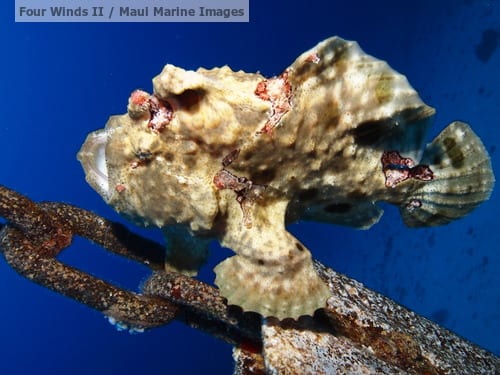 When you join us for a snorkel tour to Molokini crater, Coral Gardens or elsewhere on either the Maui Magic or the Four Winds II, you never know what you might encounter! This very rare shot of a Frogfish was quite a “catch”!
When you join us for a snorkel tour to Molokini crater, Coral Gardens or elsewhere on either the Maui Magic or the Four Winds II, you never know what you might encounter! This very rare shot of a Frogfish was quite a “catch”!
Frogfish are full of surprises, from their adaptive colors, shapes and elasticity, to their hunting ability and mobility. Considered “ambush predators” of the ocean, there are over 45 species differing vastly in appearance.
Unlike other fish, the Frogfish doesn’t really swim, rather, they walk with developed leg-like fins and webbed feet. They are able to propel themselves through the oceans by forcing water out through their gill holes, just under or behind their pectoral fins.
Frogfish are so well camouflaged and adapted to their immediate surroundings, that they are rarely detected and generally do not move very much, preferring to lie on the sea floor and wait for prey to approach. They’re also sometimes seen perched or hanging from corals and sponges, underwater pilings, mooring weights, rope or discarded debris at various angles while they wait for their meals to arrive. Who would’ve thought you could get delivery on the ocean floor?
Nudibranch
A nudibranch is a type of sea slug and a member of “Nudibranchia”, a group of soft-bodied, marine gastropod mollusks which shed their shell after their larval stage. They are noted for their extraordinary colors and striking forms with over 3,000 known species in existence and new species still being discovered.
Nudibranchs can be found in seas worldwide, including both the tropics and Antarctica and live in virtually all depths of salt water, including the inter-tidal zone to depths of well over 2,000 feet, with the greatest diversity seen in warm, shallow reefs.
Nudibranchs move on a flat, broad muscle called a foot, which leaves a slimy trail. They are usually found on the ocean floor, but some can swim short distances in the water column by flexing their muscles.
They range in size from a few millimeters to a foot long, and can weigh up to about 3 pounds and are endowed with such fantastic coloration and color patterns, they deserve to be called gems of the sea!
Orangeband Surgeonfish
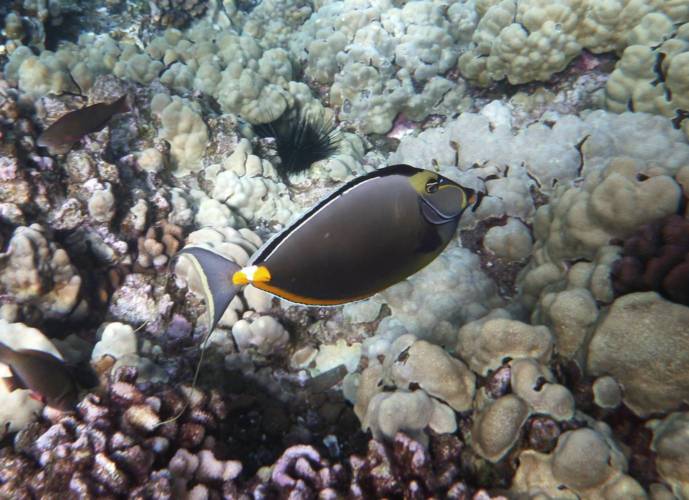 There are over 80 species of surgeonfish worldwide with 25 of these varieties living in Hawaiian waters. Although they come in many different color variations, they all share the same basic structure. The name “surgeonfish” comes from their hard spines at the base of their tail. They have one spine on each side of their body that lies flat in a groove until the fish is provoked. In times of danger, a surgeonfish will flip its tail and the spines pop out like small knives. They resemble a surgeons’ scalpel, thus the name surgeonfish. The Orangeband Surgeonfish is quickly recognized by its orange spot or band, but it also goes through a fascinating color change as it matures. As a juvenile is solid yellow with just the slightest hint of blue edging the anal and dorsal fins. The adult looks quite different. The front half of a mature specimen (in this picture) is a light gray and the back half is a dark gray. In each case it still retains its shoulder marking, but the orange spot does becomes more brilliant with age. Surgeonfish are herbivores and reside in the shallow waters of the coral reef. They feed on algae, so look for them near rocks that get a lot of filtered sunlight. The Orangeband variety swim in schools along the sandy ocean floor and eat the scraps from other fish. They are like the garbage men of the region.
There are over 80 species of surgeonfish worldwide with 25 of these varieties living in Hawaiian waters. Although they come in many different color variations, they all share the same basic structure. The name “surgeonfish” comes from their hard spines at the base of their tail. They have one spine on each side of their body that lies flat in a groove until the fish is provoked. In times of danger, a surgeonfish will flip its tail and the spines pop out like small knives. They resemble a surgeons’ scalpel, thus the name surgeonfish. The Orangeband Surgeonfish is quickly recognized by its orange spot or band, but it also goes through a fascinating color change as it matures. As a juvenile is solid yellow with just the slightest hint of blue edging the anal and dorsal fins. The adult looks quite different. The front half of a mature specimen (in this picture) is a light gray and the back half is a dark gray. In each case it still retains its shoulder marking, but the orange spot does becomes more brilliant with age. Surgeonfish are herbivores and reside in the shallow waters of the coral reef. They feed on algae, so look for them near rocks that get a lot of filtered sunlight. The Orangeband variety swim in schools along the sandy ocean floor and eat the scraps from other fish. They are like the garbage men of the region.
Yellowfin Surgeonfish
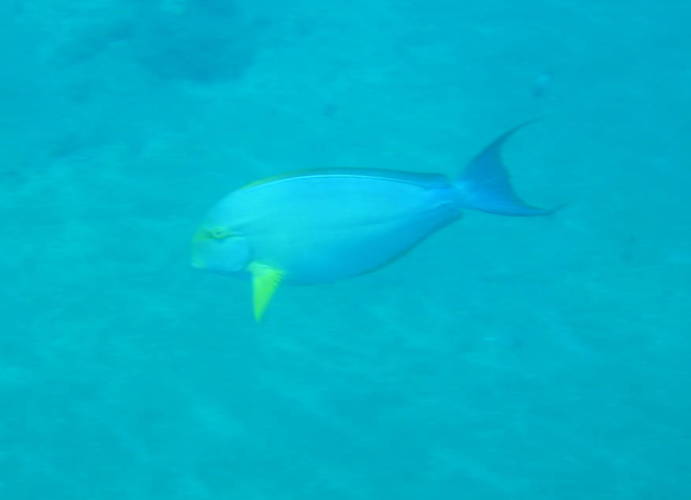 The Yellowfin surgeonfish one of the species of salt water sea fish that change color as they get older. When still young it deserves its name since the color of its tail is a beautiful yellow. After metamorphosis the color changes and the fish becomes completely purple blue or violet, only the pecotral or side fins keeping a yellow fringe. They are the largest of their species, reaching up to over 27 inches and are found over the largest geographic area of the globe. They are also found at some of the greatest depths, having reportedly been observed by submarines at 295 feet deep. Their eating habits lean towards crushed living coral, however they love to snack on the algae on the sides of the boats giving us a chance to check them out up close!
The Yellowfin surgeonfish one of the species of salt water sea fish that change color as they get older. When still young it deserves its name since the color of its tail is a beautiful yellow. After metamorphosis the color changes and the fish becomes completely purple blue or violet, only the pecotral or side fins keeping a yellow fringe. They are the largest of their species, reaching up to over 27 inches and are found over the largest geographic area of the globe. They are also found at some of the greatest depths, having reportedly been observed by submarines at 295 feet deep. Their eating habits lean towards crushed living coral, however they love to snack on the algae on the sides of the boats giving us a chance to check them out up close!
What you might see at Molokini…
Yellow Tang, also called “naughty tang”, are in the surgeonfish family. Adult fish can grow to 7 to 8 inches in length, and roughly .5 to .75 inches in thickness. Adult males tend to be larger than females. All individuals of this species are bright daffodil yellow in color. At night, the yellow colouring fades slightly and a prominent brownish patch develops in the middle with a horizontal white band. They rapidly resume their solid bright yellow color with daylight.
They have an arrow-like shape due to their dorsal and ventral fins being almost an extension to their bodies, and a long snout-like mouth used (as with other tangs) to eat the algae off rocks. They also have a sharp spine located near their tail. They have become one of the highest export fish for aquariams out of Hawaii. You’ll spot the yellow tang in the film Finding Nemo as the character Bubbles, as well as, one of the viewable fish in Nintendo’s Endless Ocean for the Wii.
The Raccoon Butterfly fish is one of the hardier of the butterfly species. In the wild it is primarily nocturnal, meaning that it is most active at night. These Butterflyfish can reach up to 8 inches and are usually found in pairs on the shallow reefs. Although the coloration of this group varies quite a lot, they are all largish butterflyfishes with an oval outline, and most have a pattern of ascending oblique stripes on the flanks.
Moorish Idol: The Reef Fish
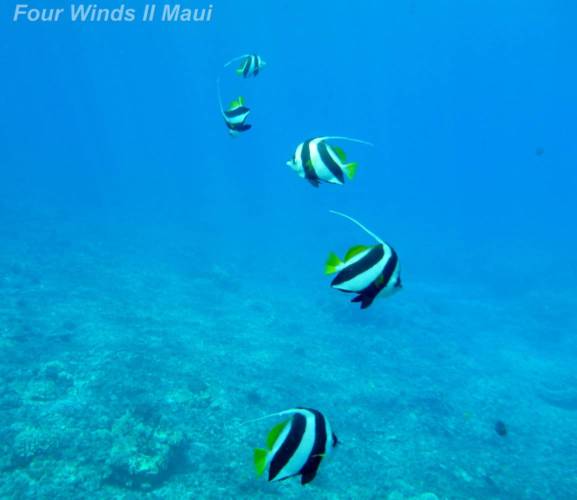 The moorish idol is a favorite reef fish that is the sole representative of the Zanclidae family. You might recognize it from it’s popular role, “Gill” in the move Finding Nemo. It is said the moorish idol got its name from the Moors of Africa, who believed the fish to be a bringer of happiness.
The moorish idol is a favorite reef fish that is the sole representative of the Zanclidae family. You might recognize it from it’s popular role, “Gill” in the move Finding Nemo. It is said the moorish idol got its name from the Moors of Africa, who believed the fish to be a bringer of happiness.
With distinctively compressed and disk-like bodies similar to a butterfly fish, moorish idols stand out in contrasting bands of black, white and yellow which make them look very attractive to aquarium keepers. The fish have relatively small fins, except for the dorsal fin whose 6 or 7 spines are elongated to form a trailing, curved-shaped crest that actually shortens with age. Moorish idols have small mouths at the end of long, tubular snouts, with many long bristle-like teeth line the mouth. Moorish idols usually reach anywhere from 7-9 inches and often are confused with the similar looking pennant coralfish.
Trumpet Fish
Whether we realize it or not, the fishes in Hawaii (and elsewhere, world-wide) are quite remarkable. The Trumpet fish definitely not an exception …. It is actually quite an amazing species when you know the facts.
The Trumpet fish is known locally as the “nunu” and can be spotted in caves, lying under ledges, and in both shallow and deep waters (up to about 100 meters or 328 feet). Sometimes it was bright yellow, other times it had a dark coloration. It is generally long and thin (much like the Needle fish or Cornet fish, both in the same family) but easily distinguished by the complex shape of its head.
They’ve adopted a few pretty ingenious hunting strategies to get what they want; their prey is usually reef fish or shrimp. They might hang motionless in the water, in sync with the wave action, and then lunge forward, inflating their trumpet-like mouth and vacuuming up their meal. It’s not surprising to see one sneak alongside a school of grazing Surgeon fishes to get within striking distance. Another tactic is to hover vertically against the backdrop of branching coral.
They can also change their coloration from grayish to yellow, or an orange-brown. The dorsal and anal fins are set back towards the tail, and small movements of these fins can propel it forward and back. Distinguishing features of the trumpet fish include a fan-shaped tail (called a “caudal”) fin and a chin (called a barbell).
Unicorn Fish
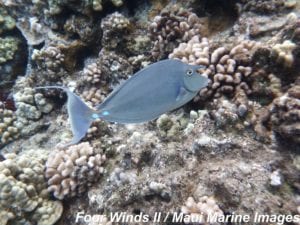 Unicorn Fish are Herbivores and are primarily active during daytime hours, swimming in groups, feeding on algae.
Unicorn Fish are Herbivores and are primarily active during daytime hours, swimming in groups, feeding on algae.
They are closely related to tangs and surgeonfish and can grow to about 20-24 inches in length, though their skin is smooth and less susceptible to skin diseases than that of other tangs. They prefer water temperatures of degrees 75-79 fahrenheit.
The horn-like appendage between their eyes begins growing when a young fish reaches about 5 inches in length and tends to be a little bigger on males. Unicorn fish are generally not aggressive to each other, but when they do fight they use sharp scalpels by their tails as weapons, not their horns.
Puffer Fish
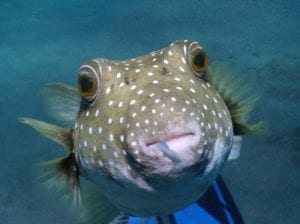 This particular puffer fish comes up to see us almost everytime we are in coral gardens. He’s a friendly and curious little guy, that loves our videographer!
This particular puffer fish comes up to see us almost everytime we are in coral gardens. He’s a friendly and curious little guy, that loves our videographer!
The family includes many familiar species which are variously called puffers, balloonfish, blowfish, bubblefish, globefish, swellfish, toadfish, and toadies. Puffer Fish are the second most poisonous vertebrate in the world, the first being a Goldon Poison Frog. The skin and certain internal organs of many puffers are highly toxic to humans, but nevertheless the meat of some species is considered a delicacy in both Japan and Korea. If one is caught while fishing, it is recommended that thick gloves are worn to avoid poisoning and getting bitten when removing the hook. As a defense mechanism, puffers have the ability to inflate rapidly, filling their extremely elastic stomachs with water until they are more circular (balloon) in shape. Thus, a hungry predator stalking the puffers may suddenly find itself facing what seems to be a much larger fish and pause, giving the puffers an opportunity to retreat to safety.
Whale Shark: The Largest Fish in the Sea
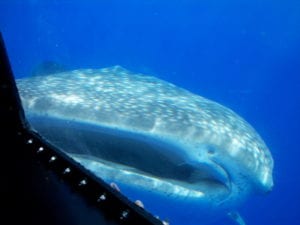 The afternoon snorkel trip got one heck of a show the other day, when a Whale Shark came right up to the boat to investigate! The whale shark is a slow moving, filter feeding shark which actually makes it more of whale than a shark. It is the largest living fish species and can grow up to 40 ft. in length and weigh up to 15 tons! This creature is distinctively-marked with white spots and is the only member of it’s family. The species is believed to have originated about 60 million years ago and is thought to live for about 70 years. Despite its enormous size, the whale shark does not pose any significant danger to humans. It is a frequently cited example when educating the public about the popular misconceptions of all sharks as “man-eaters”. They are actually quite gentle and can be playful with divers. This is not to say you shouldn’t use caution if you end up snorkeling around one! This particular animal was extremely curious about our glass bottom, and in fact, swam right up to it and looked in to check us out! It was like a reverse aquarium! All the passengers got a great look and the videographer got some fantastic shots!
The afternoon snorkel trip got one heck of a show the other day, when a Whale Shark came right up to the boat to investigate! The whale shark is a slow moving, filter feeding shark which actually makes it more of whale than a shark. It is the largest living fish species and can grow up to 40 ft. in length and weigh up to 15 tons! This creature is distinctively-marked with white spots and is the only member of it’s family. The species is believed to have originated about 60 million years ago and is thought to live for about 70 years. Despite its enormous size, the whale shark does not pose any significant danger to humans. It is a frequently cited example when educating the public about the popular misconceptions of all sharks as “man-eaters”. They are actually quite gentle and can be playful with divers. This is not to say you shouldn’t use caution if you end up snorkeling around one! This particular animal was extremely curious about our glass bottom, and in fact, swam right up to it and looked in to check us out! It was like a reverse aquarium! All the passengers got a great look and the videographer got some fantastic shots!
Discover Maui – A Review From One of Our Guests
We had a truly magnificent day on the Maui Magic today, with all kinds of wildlife throughout the morning. Right outside of the harbor we came across a female humpback whale just logging on the surface, perfect way to start the day. We continued down our usual coarse toward Makena, and came upon a baby humpback whale breaching over and over, he gave us quite a show! Next was a typical stop down in La Perouse Bay to check out some of the last lava flows on Maui. That is where we discovered the spinner dolphins frolicking around. All this before we even put anyone in the water…..amazing! We made it to Molokini for our first snorkel spot. It was perfectly calm and insanely clear so it doesn’t get much better then the crater for snorkeling. From there we headed to the coast line for our 2nd snorkel, and on our way came across some bottlenose dolphins. They swam around us a bit and gave us a short hello, then they were on their way…and so were we. Off to Turtle Arches we go! The visibility was very good, and everyone that went in the water had a chance to swim with a turtle. Even the people that elected to hang out with us on the boat witnessed a turtle surface and go right underneath the vessel, too much! In all, a tremendous day for the passengers and crew on the Maui Magic!
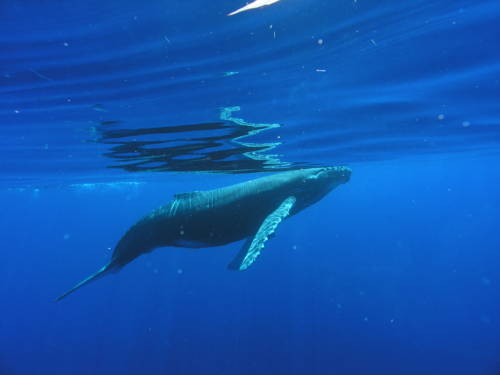
Red Pencil Urchins & Parrot Fish
Creatures that Live Under the Sea
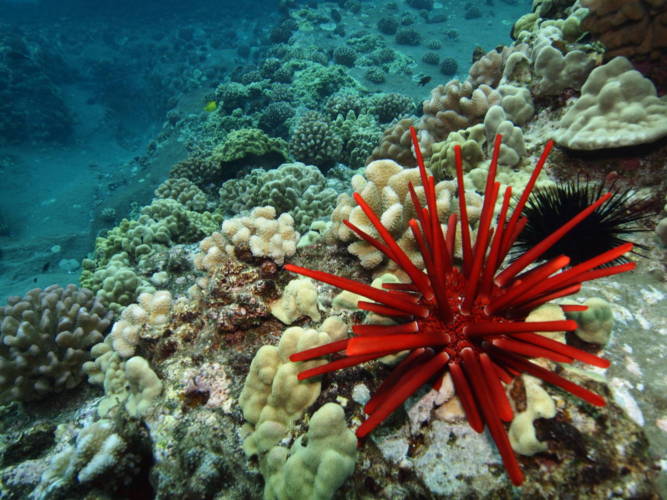 Among the many things you will see on a snorkeling tour to Molokini Crater or elsewhere from Maui, the Red Pencil Urchin is a very easy to see “bright spot”!
Among the many things you will see on a snorkeling tour to Molokini Crater or elsewhere from Maui, the Red Pencil Urchin is a very easy to see “bright spot”!
They tend to remain in rocky sub-tidal habitats, just below the low tide line where the wave action is not extreme and to avoid sandy or muddy locations.
The Urchin has a body that is domed above and flat below, with it’s external skeleton, called the “test”, comprised of 10 fused, chalky plates covered with spines.
Every other section has holes through which the urchin’s “feet” are extended among the spines (called “tube feet”). These are actually long, thin, flexible tentacles with small suction cups.
It’s spines are connected to the “test” by ball joints that enable them to point in all directions. Also located among the spines and near the mouth are pincer-like structures called pedicellaria.
Red Sea Urchins maintain a diet of attached or drift seaweed and kelp. Their “teeth” are used to scrape algae off rocks. Urchins may hold onto kelp with their tube feet as they eat, or, if algae lands on top of one, may use a combination of its spines and tube feet to pass the food to its bottom located mouth.
Upon first glance, sea urchins appear incapable of moving. Sometimes, the most visible life sign is the spines, which can point in any direction. In most urchins, touch elicits a prompt reaction from the spines, which converge toward the touch point. Sea urchins have no visible eyes, legs, or means of propulsion, but can move freely over hard surfaces, using their adhesive tube feet and spines to help it move and to stay in place on the ocean floors.
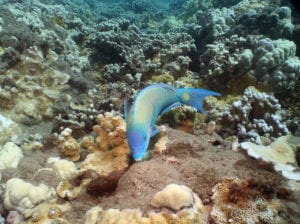 It’s hard to decide which of the colorful parrot fish’s many unique characteristics is most remarkable!
It’s hard to decide which of the colorful parrot fish’s many unique characteristics is most remarkable!
There’s its diet, which consists primarily of algae taken from pieces coral ripped from a reef with their tusk-like teeth that are fused together forming a beak, hence the “parrot fish”. The coral is ground down with their teeth in the fishes’ throats and made into sand. Much of the sand in the parrot fish’s range is actually the ground-up, undigested coral they excrete. There’s its gender, which they can change repeatedly throughout their lives, and their coloration and patterns, which are absolutely amazing and vary greatly, even between the males, females, and juveniles of the same species.
Finally, there are the pajamas. Every night, certain species of parrot fish envelope themselves in a transparent cocoon made of mucous secreted from an organ on their head. Scientists think the cocoon masks their scent, making them harder for nocturnal predators, like moray eels, to find.
Black Durgoen
One of the most common fish at our snorkel sites is the Black Durgeon, a fish in the Trigger family. The Hawaiian name for this fish is Hu-mu hu-mu ‘e-le-‘e-le. It’s said that the fish is very oily and not good to eat. When they were caught in the ancient days, they would be dried on the rocks, then used as torches.
The Black Durgeons usually get up to 12 inches, but can attain up to 14 inches. It’s a very active fish that needs lots of room to move around, and plenty of shelter for hiding. Unlike most other Triggers that live a solitary life on the reef, the Hawaiian Black Trigger is different. Each one has its own house to live in amoungst the coral and rock formations just outside the reef, but they will emerge and congregate above near the surface of the water in a large schools to feed on current drifting zooplankton and algaes.
Potter’s Angelfish
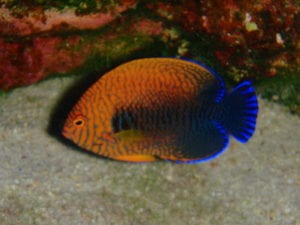 An endemic species to waters around Hawaii, the Potter’s Angelfish inhabit reef slopes, rocky ledges, and rubble areas of the Hawaiian Islands. These fish live in clear water from 10-150’ and will reach anywhere from 2-4 inches. The body has an oval shape which is brilliantly colored with orange over the front and upper sides. It is marked by many vertical lines of dark blue-purple or black, which sometimes are so dense as to make the lower and posterior parts of the body appear as a solid, beautiful deep blue color.
An endemic species to waters around Hawaii, the Potter’s Angelfish inhabit reef slopes, rocky ledges, and rubble areas of the Hawaiian Islands. These fish live in clear water from 10-150’ and will reach anywhere from 2-4 inches. The body has an oval shape which is brilliantly colored with orange over the front and upper sides. It is marked by many vertical lines of dark blue-purple or black, which sometimes are so dense as to make the lower and posterior parts of the body appear as a solid, beautiful deep blue color.
The Potter’s Angelfish, like other angels, is an egg laying fish that start out sexually undifferentiated and develop into females, with the most dominant transforming to male. They are generally found in harems with a dominant male and several females. The naming of this fish honors the memory of Mr. Frederick A. Potter (1874-1961), who served from 1903 to 1940 as the first Director of the Waikiki Aquarium.
When I first came to Maui, I never thought I’d get this one but soon found it to be quite easy when sounded out. Before we get into further discussion of this beauty, let’s learn how to pronounce the name properly … “who-moo-who-moo-noo-koo-noo-koo-ah-poo-ah-ah”.

